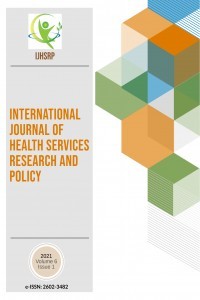EFFICIENCY, EQUITY, AND EFFECTIVENESS OF MALARIA FUNDING IN UGANDA: MAKING THE CASE FOR REFORMING PUBLIC FINANCING FOR HEALTH
EFFICIENCY, EQUITY, AND EFFECTIVENESS OF MALARIA FUNDING IN UGANDA: MAKING THE CASE FOR REFORMING PUBLIC FINANCING FOR HEALTH
Malaria, Public financing Effectiveness, Uganda,
___
- [1] Government of Uganda, "Second National Development Plan (NDPII) 2015/16 – 2019/20: Uganda Vision 2040- A Transformed Ugandan Society from a Peasant to a Modern and Prosperous Country within 30 years," Government of Uganda (GOU), Kampala2015.
- [2] Uganda Bureau of Statistics, "Statistical abstract," Uganda Bureau of Statistics, Kampala2017.
- [3] WHO, "World Malaria Report," World Health Organization, Geneva2017.
- [4] WHO, "World Malaria Report," World Health Organization, Geneva2018.
- [5] Ministry of Health, "Malaria Control Program," Minstry of Health, Kampala. Available: http://health.go.ug/programs/national-malaria-control-program2018.
- [6] Ministry of Health, "Malaria Indicator Survey (MIS) 2014-15," Government of Uganda, Kampala2015.
- [7] Ministry of Health, "National Health Accounts: Financial Years 2010/11 & 2011/12," Government of Uganda, Kampala2012.
- [8] Ministry of Health, "Uganda Health Accounts: National Health Expenditure- Financial Years 2010/11 and 2011/12," Government of Uganda, Kampala2014.
- [9] Ministry of Health, "National Health Accounts: Financial Years 2012/13 & 2013/14," Government of Uganda, Kampala2015.
- [10] Ministry of Health, "National Health Accounts 2015/16," Government of Uganda, Kampala2017.
- [11] President's Malaria Initiative, "PMI Malaria Operational Plan FY2018," PMI. Available: https://www.pmi.gov/docs/default-source/default-document-library/malaria-operational-plans/fy-2018/fy-2018-uganda-malaria-operational-plan.pdf?sfvrsn=112018.
- [12] WHO, "World Malaria Report," World Health Organization, Geneva2009, vol. Available: http://www.who.int/malaria/world_malaria_report_2009/mal2009_rep_chap6_0041.pdf.
- [13] Coalition for Health Promotion & Social Development (HEPS), "Cost and Pricing: An Assessment of Private Health Facilities in Uganda " Cardno Emerging Markets USA, Ltd. Available: http://uhfug.com/wp-content/uploads/2017/04/An-assessment-Of-Private-Health-Facilities-In-Uganda.pdf2014.
- [14] WHO, "Medicine Price Monitor for Uganda No. 13: May-June 2015," World Health Organization. Available: http://apps.who.int/medicinedocs/en/m/abstract/Js22317en/2015.
- [15] The Global Fund, "Audit Report: Global Fund Grants to the Republic of Uganda," Global Fund, Geneva2016.
- [16] Ministry of Health, "Uganda Malaria Quarterly Bulletin," Government of Uganda2016, vol. Issue 14.
- [17] National Malaria Control Programme & INFORM Project, "An epidemiological profile of malaria and its control in Uganda," in "Available: http://www.inform-malaria.org/wp-content/uploads/2014/05/Uganda-Epi-Report-060214.pdf," 2013.
- [18] Uganda Bureau of Statistics and ICF, "Uganda Demographic and Health Survey 2016: Key Indicators Report," Uganda Bureau of Statistics (UBOS) and ICF, Kampala, Uganda and Rockville, Maryland, USA:2017.
- [19] Uganda Bureau of Statistics, "The 2016/17 Uganda National Household Survey " Uganda Bureau of Statistics (UBOS), Kampala2017.
- [20] G. Stedman-Bryce, F. Schatz, C. Hodgkin, and P. Balogun, "Medicines Transparency Alliance (MeTA) Evaluation: Testing MeTA’s underlying intervention logic," e-PACT. , Available: http://haiweb.org/wp-content/uploads/2016/11/Medicines-Transparency-Alliance-MeTA-Evaluation.pdf2015.
- [21] WHO, "Medicine Price Monitor for Uganda No. 11: July - September 2013," World Health Organization. Available: http://apps.who.int/medicinedocs/documents/s21906en/s21906en.pdf2013.
- [22] WHO, "Medicine Price Monitor for Uganda Uganda No. 12 July-September 2014," World Health Organization. Available: http://apps.who.int/medicinedocs/documents/s22316en/s22316en.pdf2014.
- [23] IHME, "Assessing Facility Capacity, Costs of Care, and Patient Perspectives," University of Washington, Seattle: Available: https://www.healthdata.org/sites/default/files/files/policy_report/2014/ABCE/Uganda/ABCE_Uganda_full_report_2014.pdf2014.
- [24] D. McIntyre and J. Kutzin, "Health financing country diagnostic: a foundation for national strategy development," in "Health Financing Guidance No. 1: WHO/HIS/HGF/HFGuidance/16.1," World health Organization, Geneva2016.
- [25] WHO, "Sustainable health financing, universal coverage and social health insurance. World Health Assembly Resolution WHA58.33," World Health Organization, Geneva2005.
- [26] G. Carrin and C. James, "Reaching universal coverage via social health insurance: key design features in the transition period [Discussion paper no. 2]," World Health Organization, Geneva2004.
- [27] D. McIntyre, "Pay the piper and call the tune: changing health care financing mechanisms to address public-private health sector mix inequities," (The economics of health equity. Cambridge: Cambridge University Press, 2007, p.^pp. Pages.
- [28] WHO, "Domestic resource mobilization for sustainable financing for health in Africa African Region. Working Paper prepared by the WHO Regional Office for Africa," World Health Organization, Geneva2017.
- [29] R. Tamarappoo, P. Pooja, R. Muthu, and F. Jincy, "Analysis of the linkage between domestic revenue mobilization and social sector spending: Phase 1 Final Report Leadership in Public Financial Management II (LPFM II)," Nathan Associates Inc.2016.
- [30] R. Busse, J. Figueras, R. Robinson, and E. Jakubowski, "Strategic purchasing to improve health system performance: Key issues and trends " in Healthcare Papers, ed, 2006.
- [31] RESYST. (2014). What is strategic purchasing for health? Available: https://resyst.lshtm.ac.uk/sites/resyst/files/content/attachments/2018-08-22/What%20is%20strategic%20purchasing%20for%20health.pdf
- [32] T. Bright, L. Felix, H. Kuper, and S. Polack, "A systematic review of strategies to increase access to health services among children in low and middle income countries," BMC Health Serv Res, vol. 17, no. 1, p. 252, Apr 5 2017.
- [33] A. Cameron, M. Ewen, D. Ross-Degnan, D. Ball, and R. Laing, "Medicine prices, availability, and affordability in 36 developing and middle-income countries: a secondary analysis," Lancet, vol. 373, no. 9659, pp. 240-9, Jan 17 2009.
- [34] K. M. Leisinger, L. F. Garabedian, and A. K. Wagner, "Improving access to medicines in low and middle income countries: corporate responsibilities in context," South Med Rev, vol. 5, no. 2, pp. 3-8, Dec 2012.
- [35] Y. Lu, P. Hernandez, D. Abegunde, and T. Edejer, "The World's Medicines Situation," Available: http://digicollection.org/hss/documents/s18767en/s18767en.pdf2011.
- Yayın Aralığı: Yılda 3 Sayı
- Başlangıç: 2016
- Yayıncı: Rojan GÜMÜŞ
THE STUDY OF THE LONG-LIVERS DYNAMICS IN THE POPULATIONS OF ADJARA IN 2012-2017
Marina KORİDZE, Rusudan KHUKHUNAISHVILI, Temur KARTSIVADZE, Sophiko TSKVITINIDZE, İrina NAKASHIDZE, Kristine MAKHARADZE
Yusuf NERGİZ, Engin DEVECİ, Muhammet Erdal SAK, Mehmet Sıddık EVSEN, Cenap EKİNCİ, Sebnem NERGİZ, Beyza KARADEDE UNAL, Ugur SEKER
CARRIERS OF CHROMOSOME TRANSLOCATIONS FROM THREE MEN WITH AZOOSPERMIA
Gülbahar GÜZEL ERDAL, Mahmut BALKAN
Bahar KARTAL, Mehmet Tahir HATİPOĞLU, Ümit Ali KAYIŞLI, Sevtap HAMDEMİR KILIÇ, Evrim ÜNSAL, Candan ÖZOĞUL
FRAILTY AMONG THE BENEFICIARIES OF BATUMI ST. CATHERINE NURSING HOME
Rusudan KHUKHUNAİSHVİLİ, Marina Koridze KORIDZE, Kristine Makharadze MAKHARADZE, Sophiko Tskvitinidze TSKVITINIDZE, Marina Nagervadze NAGERVADZE, İrina Nakashidze NAKASHIDZE, İrakli PARULAVA
JOB SATISFACTION AS AN OBJECTIVE INDICATOR OF WORK MOTIVATION AMONG INTENSIVE CARE UNIT (ICU) NURSES
Dejan ŽİVANOVİĆ, Jovan JAVORAC, Branislava BRESTOVAČKI SVITLICA, Svetlana STOJKOV
